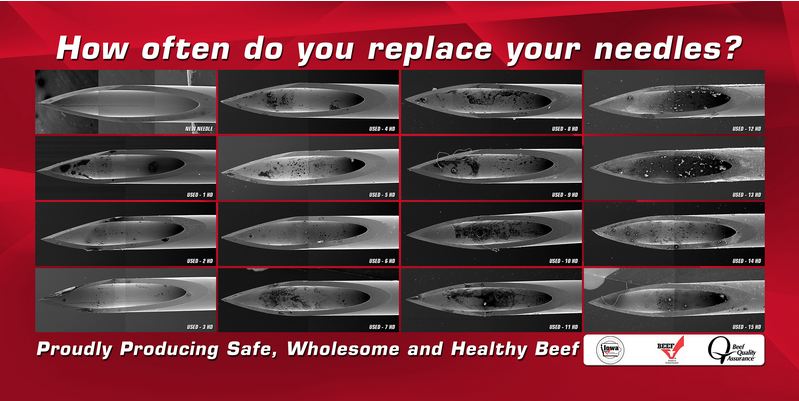



Effective Biosecurity Planning - Regularly Changing Needles
Having a biosecurity plan is all about ensuring the end product is safe and wholesome for the consumer's plate and can be made easier by a five point plan.This may be accomplished by preventing, minimizing or controlling cross-contamination either directly (animal-to-animal) or indirectly (animal-to-feed or animal-to-equipment-to-animal), writes Doug Bear, Directory of Industry Relations at the Iowa Beef Industry Council.
He adds that the five components of an effective biosecurity plan on the farm include A-RITS: assessment (A), resistance (R), isolation (I), traffic control (T), and sanitation (S).
- Assessment of the potential for disease organisms to enter a livestock herd is the first step.
- Resistance refers to an animal's ability to reject or contend with an infectious agent.
- Isolation refers to the prevention of contact between animals within a controlled environment.
- Traffic Control includes traffic entering an operation and traffic patterns within an operation.
- Sanitation addresses the cleaning and disinfection of materials, people and equipment entering the operation and their cleanliness on the operation. Typically things that are hard to clean . . . will not get cleaned.
One component of biosecurity that we will address is sanitation. What is our only direct connection to the cattle that we are vaccinating, treating and/or implanting? If you replied, "Through a needle!"- You would be absolutely correct. But, how often do you change your needles when working cattle? How often should you be changing needles? If your answers contrast in the slightest, then a management change must be implemented. In accordance with Beef Quality Assurance (BQA) guidelines, a needle should be regularly changed at least every ten to fifteen head of cattle.
While it may not have immediate consequences, look at effects that may be experienced by not regularly changing needles and implementing this easy method of sanitation. In the Midwest during the past couple of years, there have been an increasing number of documented cases of Anaplamosis. While not contagious, it may be spread through the use of contaminated needles or dehorning or other surgical instruments (Merck Veterinary Manual, 1998). Therefore, one way to inhibit the disease transmission cycle from occurring on cow-calf farms is to encourage changing needles more frequently, even to the extreme management that a separate needle may need to be utilized per cow.
Two of the sanitation topics related to needle replacement are wear and biological contamination - Why do we need to replace needles after 15 head? What does a needle look like only after a few uses? Can't a needle be until it visually looks damaged? After a substantial number of questions were asked over a short duration of time, a small on-farm experiment was created to provide answers and examples of used needles to be used to remind of the importance of regularly changing needles in accordance with BQA guidelines.
The needle project was conducted by the generous assistance of a local feedyard operator and crew. The feedyard was provided a full box of 16 ga. X 1" needles for administering an intramuscular (IM) product to a group of calves sourced from a similar region of the United States. The working crew was instructed after a needle was used on one head to put it into a bag labeled (1 hd), used on two head put into a labeled bag (2 hd), and continued in this manner until a needle was used on fifteen consecutive head (15 hd) of processed cattle.
Each individual needle was evaluated and photographed under a high powered Scanning-Electron Microscope. The attached JPEG provide a snapshot of needles used on sequential number of cattle administered an IM product before changing to a new needle.
*Disclaimer: While there was an attempt to minimize on-farm variables by utilizing the same person to administer all injections, same box of needles and group of sourced cattle, these magnified results may not be representative in all situations. However, this resource demonstrates the importance of regularly changing needles on the farm.
Note the increase in biologic contamination and compromised structural integrity using a needle in sequential order. This information should encourage beef and dairy farmers to regularly change needles at least every fifteen head when administering injections.



